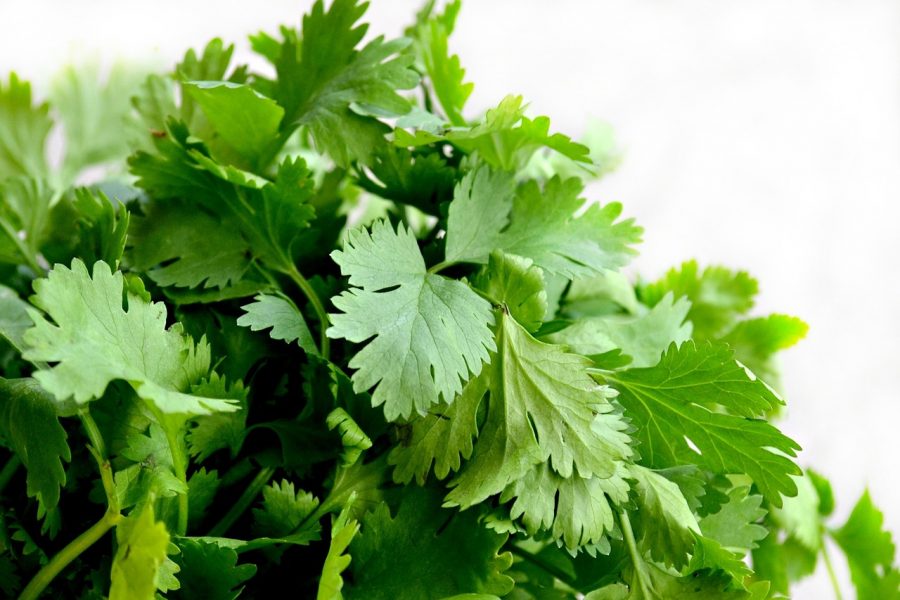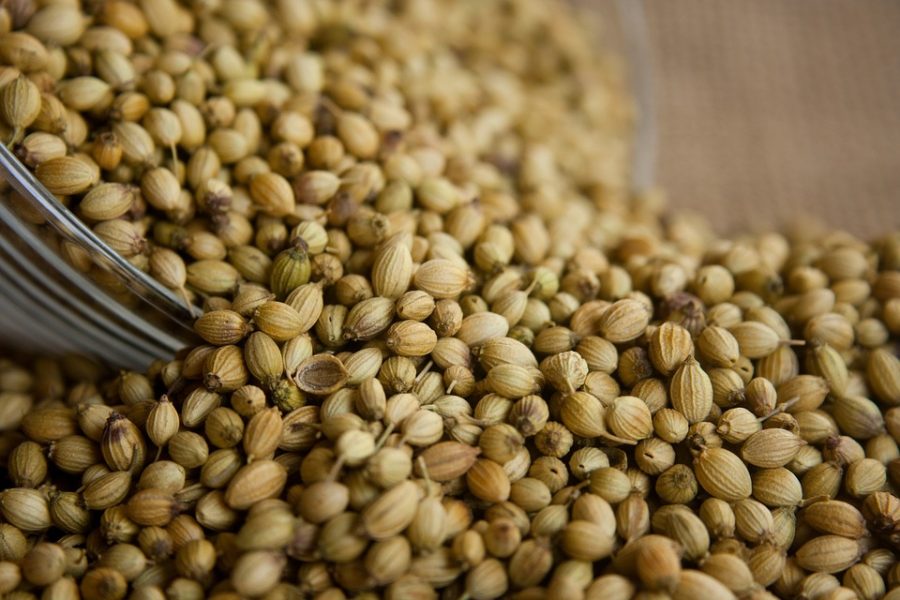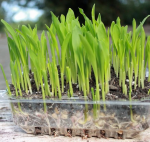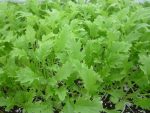This post contains affiliate links. If you buy something from one of our links we may earn a commission. Thanks

Do you love cilantro? Did you know that you can grow it yourself, right in your own home? In this blog post, we will teach you how to grow cilantro microgreens in just 7 easy steps.
Key Takeaways
• Growing Cilantro Microgreens involves selecting a suitable container, filling it with growing medium, spreading cilantro seeds evenly.
• Lightly press them into the soil, and mist them with water.
• Place the container in a well-lit area, ensuring they receive sunlight or artificial light for at least 8 hours daily.
• Mist them regularly to keep the soil moist.
• In about 14 to 21 days, once the first true leaves appear, they’re ready to be harvested and enjoyed in various dishes.
Microgreens are a great way to get your daily dose of vitamins and minerals, and they are also incredibly delicious.
Cilantro is a particularly good choice for microgreens because it has a strong flavor that stands out against other herbs.
So, what are you waiting for? Start growing your own cilantro microgreens at home today.
What Are Cilantro Microgreens?
Cilantro is an aromatic herb commonly used in Mexican, Southeast Asian, and Indian cuisines.
It has lacy green leaves with a distinctive citrus taste that adds a burst of flavor to any dish.
Cilantro microgreens are baby plants grown from cilantro seeds that can be harvested after only two to three weeks of cultivation.
Though small in size their flavor is intense – even more pronounced than the mature herb – and their delicate shape adds visual appeal to salads, tacos, or rice dishes.
They can also be eaten raw – tossed in dips or added to sandwiches for a flavorful zing! Cilantro microgreens are great for incorporating freshness into your favorite dishes without having to maintain a full-fledged garden of herbs.
Are Cilantro And Coriander The Same?
Have you ever noticed the herb aisle in your local grocery store can be confusing? You may not be aware, but cilantro and coriander are actually the same plants.
The difference is only in how they look and how they’re used. Cilantro is the leaves of the coriander plant; while coriander is the seeds that come from it.
This unusual relationship between two dissimilar products has been enjoyed throughout cultures for centuries, adding a distinct flavor to some foods.
Moreover, these herbs contain various nutritional benefits such as providing vitamins, minerals, antioxidants, and dietary fiber.
Technically I guess you could call them coriander microgreens as well as cilantro microgreens.
It is in the Apiaceae aka Umbelliferae family (think celery, carrot, or parsley).
According to Wikipedia:
Coriander Coriandrum sativum) is an annual herb in the family Apiaceae. It is also known as Chinese parsley, dhania, or cilantro.
All parts of the plant are edible, but the fresh leaves and the dried seeds (which are both a herb and a spice) are the parts most traditionally used in cooking.
Most people perceive coriander as having a tart, lemon/lime taste, but to nearly a quarter of those surveyed, the leaves taste like dish soap, linked to a gene that detects some specific aldehydes that can produce soapy sensation from the odorant substances.
Cilantro Microgreens Seeds

 Cilantro microgreens seeds have rapidly become popular among home gardeners and farmers alike.
Cilantro microgreens seeds have rapidly become popular among home gardeners and farmers alike.
They are known for their strong flavor, deep green foliage, and reliable yields.
With just a small investment of time and money, you can be harvesting your own cilantro microgreens each year!
Their growth requires little maintenance and no chemical inputs—ideal for creating a truly organic harvest.
When you look at your seeds you may notice some are split, Don’t worry about split seeds they will grow just fine.
Cilantro microgreens also provide great nutrition; they contain high levels of vitamins A, C, and K as well as carotenoids, riboflavin, zinc, calcium, iron, magnesium, potassium, and more.
Whether you are looking to improve your diet or bring fresh flavors to your kitchen table, cilantro microgreens seeds are worth the effort!
How To Grow Cilantro Microgreens In 7 Easy Steps
Follow this simple 7 step guide and you will soon be eating your first serving of cilantro micro greens.
1. Choose a container:
 The first step in the growing process is to select an appropriately sized, shallow container that has drainage holes in the bottom. You can use recycled food containers but 1020 plant propagation trays are a better option.
The first step in the growing process is to select an appropriately sized, shallow container that has drainage holes in the bottom. You can use recycled food containers but 1020 plant propagation trays are a better option.
Shallow planting trays will use less soil and your microgreens are harvested while young so you don’t need a deep tray unless you want to grow full-grown cilantro.
Fill it with growing medium and make sure it is even and level. Coconut coir is excellent for starting seeds.
You can use potting soil as long as it is not too heavy. You can add some perlite to make it a lighter potting mix
2. Plant cilantro seeds:
Spread your cilantro seeds over the soil surface and gently press them down into the soil so they have good contact with the soil. Keep your tray at room temperature.
Remember coriander seeds and cilantro seeds are exactly the same so it does not matter which one you use.
You want to plant enough seeds so use about 6-8 seeds per square inch or about half an ounce for a 1020 tray.
Cilantro can tolerate cooler temperatures than some other microgreens.
If you cover your seeds with soil your Cilantro microgreens will grow without the seed hulls attached to the leaves.
Some people like to plant with soaked seeds but I find sowing is easier if they are dry seeds.
I don’t like to use a humidity dome because it cuts off airflow and the excess moisture it creates can lead to mold or fungal diseases. Just mist your seeds instead.
3. Water lightly:
Moisten the top layer of soil by lightly misting or spraying with cool water until evenly moist but not soggy or saturated. I like to use a spray bottle.
Spray more water on any spots that look dry and allow to drain off excess water from the container’s drainage holes. You don’t want too much water in the tray.
Wait for the germination process to complete. Usually, the amount of time this takes is 7 to 10 days.
Soaking your seed before planting may speed up germination by a couple of days but it is not really necessary.
After a couple of days, you should start to see your first sprouts poking up through the soil.
4. Place in direct sunlight:
For best results, the next step is to place your planted containers with your cilantro plants in a warm, sunny spot for at least 8 hours of sunlight per day.
If you don’t have enough natural light use an LED grow light to add supplemental lighting.
5. Mist often:
Cilantro microgreens need to be kept evenly moist, so mist them with a spray bottle. Mist the entire surface of the soil. Water your young plants every day or two and more frequently if the soil begins to dry out.
6. Harvest Time in 14 -21 days:
After about 14 days, you should have a full crop of cilantro microgreens. When they have their first true leaves they are ready to harvest.
This is the approximate time it takes for the plants to grow the first set of true leaves.
You can opt to take a bit longer(another week or two) and harvest more mature plants as baby cilantro greens. You are really after those frilly lacy green leaves.
Snip off the stems just above the soil line with scissors, pruning shears, or a sharp knife.
Cilantro microgreens take a bit longer to grow than other microgreens because you want to harvest the leaves.
I consider them to be between microgreens and baby greens. Because you will let them get bigger you don’t need to seed as heavy as other microgreens.
7. Enjoy:
Your freshly harvested cilantro microgreens can be enjoyed right away in salads, sandwiches, or other dishes. They are packed with flavor and nutrition and will last up to a week in the refrigerator.
Place them in a plastic bag or another container with holes. Here is how to store microgreens.
Cilantro microgreen leaves can be dried and kept for up to a year. I don’t know of any other microgreen you can do this with.
Here is how to store your cilantro microgreens.
How To Grow Cilantro Microgreens Without Soil
Soil can be messy and has a way of getting into places you don’t want it. If you want to grow cilantro but have hesitated because it can be messy I have good news for you. Here are 2 ways to do it.
Easy Done For You Cilantro Growing Kit
Want an easy way to grow cilantro microgreens? Try this HAMAMA Home Microgreens Growing Kit on Amazon. Just add water and the preseeded microgreen quilt will do the rest.
Using Coco Coir Grow Mats
 If you want to grow cilantro without soil you can. For the second way to grow cilantro microgreens without soil, you will need to use coco grow mats to do this.
If you want to grow cilantro without soil you can. For the second way to grow cilantro microgreens without soil, you will need to use coco grow mats to do this.
These mats are made from long coco coir fibers and look a lot like an old-fashioned doormat although they are thinner.
This method takes a bit more doing than the microgreen kit above but it works great.
You will want to place the grow mat in a 1020 seed propagation growing tray and let it soak for about 12 hours to get it hydrated because they are dry as a bone when you buy them.
You want to use two trays. Actually, you will need three. You want a solid bottom tray but you also want a top tray that has drainage holes.
The tray with the holes has the grow mat in it along with the seeds. The solid tray is filled with some water and the top tray is placed in it to be bottom watered.
Finally, place the 3rd tray on top of the tray with the seeds to cover them.
Once your cilantro seeds have germinated and gotten their roots into the coco mat you can take the cover off and get your young plants under a grow light or by a sunny windowsill.
Spread your cilantro seeds evenly over the mat. Some people soak the seeds for about 12 hours too because it hastens germination.
That’s it to growing cilantro with no soil. It’s a no-muss, and no-fuss way to grow microgreens.
Here is a Penn State Extension article on growing microgreens.
Cilantro Microgreens Benefits
Disclaimer: I am not a physician and don’t play one on TV either. The material on this site is not a substitute for professional medical advice, diagnosis, or treatment. Always seek a physician’s advice before using any information you find on this website to treat or prevent any condition.
Cilantro microgreens are an incredibly nutritious and tasty addition to any meal. They offer a lot of health benefits too.
Bursting with flavor, each bite is full of vitamins A and C, minerals like iron and manganese, as well as essential fatty acids and phytochemicals.
These micronutrients help reduce inflammation throughout the body, leading to a stronger immune system.
Cilantro microgreens are also known for their detoxifying abilities, helping cleanse the body of toxins and aiding digestive health.
With such a powerhouse of nutrients in every bite, cilantro microgreens can be an easy way to add nutrition to any meal or snack.
Cilantro Microgreens Nutrition
Cilantro microgreens offer a powerhouse of nutrition in a very small package. Rich in nutrients like vitamins, minerals, and antioxidants, they contain more vitamin C than oranges, more vitamin K than kale, beta-carotene, and lutein combined—four times the amount found in mature cilantro.
Not only are these nutrient-dense cilantro microgreens beneficial for overall health and wellness, but consuming them has even been linked to better thyroid function, improved digestion, and stronger immune systems.
Eating cilantro microgreens can be a delicious and nutritious way to boost your daily diet.
How To Use Cilantro Microgreens
Cilantro microgreens are a flavorful and versatile addition to many dishes. They can be used as garnishes, added to smoothies or soups, or even used as the main ingredient in salads.
To prepare cilantro microgreens, simply wash them with cold water and pat them dry before use.
These nutritious greens are just as delicious raw as they are cooked, meaning you can enjoy them in a wide variety of dishes without losing any flavor.
For an extra kick of flavor, sprinkle cilantro microgreens on top of your tacos, sandwiches, curries, and other savory meals.
The addition of these flavorful greens can make any dish feel fresh and exciting!
Cilantro Microgreens FAQs
Frequently asked questions are a great way to learn more about the specifics of growing and enjoying cilantro microgreens.
The following Q & A section aims to address some common queries you might have regarding the cultivation, nutrition, and use of cilantro microgreens.
Q. What are the nutritional benefits of cilantro microgreens?
A. Cilantro microgreens are rich in vitamins A and C, minerals like iron and manganese, essential fatty acids, and phytochemicals which aid in reducing inflammation, detoxifying the body, and boosting the immune system.
Q. Can cilantro and coriander microgreens be used interchangeably?
A. Yes, cilantro and coriander refer to the same plant; cilantro refers to the leaves while coriander refers to the seeds. Both can be grown as microgreens and used interchangeably, offering a distinctive citrus flavor.
Q. How do I store cilantro microgreens after harvesting?
A. After harvesting, cilantro microgreens can be stored in a plastic bag or container with holes in a refrigerator for up to a week. They can also be dried and stored for up to a year.
Q. Can cilantro microgreens be grown without soil?
A. Yes, cilantro microgreens can be grown without soil using coco coir grow mats placed in a suitable tray, or by using a pre-seeded microgreen growing kit like the HAMAMA Home Microgreens Growing Kit.










